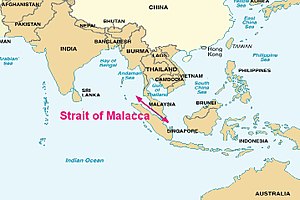Piracy in Indonesia
[1] Approximately 50,000 vessels worth of the world's trade employ the strait annually, including oil from the Persian Gulf and manufactured goods to the Middle East and Suez Canal.
[4] According to the International Maritime Bureau, the pirates are able to bypass authorities and elude detection by taking cover in numerous islands that readily surround the area.
[3][4] In addition, numerous major naval forces that use to patrol high seas has declined by fifty percent and this has adversely propelled the rate of pirate attacks in Indonesia.
[5] Many of these crimes are conducted for ransom, but there is a huge risk involved when these pirates are illegal syndicates who hijack tug boats, barges and large tankers.
[7] As supported in a research article by David Rosenberg, the number of crimes has shot up ever since the 1997 currency crisis in Indonesia, driving numerous people to becoming pirates solely to earn a living wage.
[2] However, after an attack back in the 1990s, Indonesia has partnered with Singapore and Malaysia to safeguard, monitor and ensure the security and safety of the water that borders outside their respective territory.
The MSP comprises the Malacca Strait Sea Patrol (MSSP), the Eyes in the Sky (EiS) and the Intelligence Exchange Group (IEG) and the information that is being gathered on pirate attacks in Indonesia is being facilitated and shared between the countries.
The solution, as mentioned by the director of the International Marine Bureau in London, said that good coordination and cooperation from regional governments play a part in deterring the attacks on commercial shipping, because cohesive supervision leads to a riskier task for the pirates.

